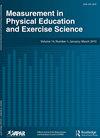年轻女性心率变异性阈值和通气阈值之间的一致性:心脏副交感神经状态和心肺健康的影响
IF 1.9
4区 教育学
Q2 EDUCATION & EDUCATIONAL RESEARCH
Measurement in Physical Education and Exercise Science
Pub Date : 2021-09-16
DOI:10.1080/1091367X.2021.1979980
引用次数: 2
摘要
摘要心率变异性阈值(HRVT)是评估通气阈值(VT)的一种有用且廉价的替代方法。然而,它在妇女中的有效性仍然没有得到充分的探索。我们研究了年轻女性HRVT和VT之间的一致性,以及心脏副交感神经状态和心肺功能(CRF)的影响。61名女性[年龄:24.5±4.6岁,BMI:23.4±2.6 kg/m2,O2max:36.6±6.1(mL(kg.min)−1)]在跑步机上进行了最大运动测试。我们使用四种方法评估HRVT:HRVTvisual、HRVTDmax、HRVT3ms、HRVT1ms。在VT和HRVTvisual之间观察到低偏倚和一致性极限[-.1(-1.5。1.3)km/h]和HRVTDmax[−.1(−1.6,1.4)km/h]方法。HRVT3ms[1(−2.1,2.1)km/h]和HRVT1ms[4(−1.8,2.7)km/h]的一致性极限较高。总之,在女性的室性心动过速和HRVT之间观察到可接受的一致性,主要是当视觉和Dmax方法用于HRVT评估时。本文章由计算机程序翻译,如有差异,请以英文原文为准。
Agreement between the Heart Rate Variability Threshold and Ventilatory Threshold in Young Women: Impact of Cardiac Parasympathetic Status and Cardiorespiratory Fitness
ABSTRACT The heart rate variability threshold (HRVT) is a useful and inexpensive alternative to estimate the ventilatory threshold (VT). However, its validity in women remains underexplored. We investigated the agreement between HRVT and VT in young women and the influence of cardiac parasympathetic status and cardiorespiratory fitness (CRF). Sixty-one women [Age: 24.5 ± 4.6 years, BMI: 23.4 ± 2.6 kg/m2, O2max: 36.6 ± 6.1 (mL (kg.min)−1)] underwent a maximal exercise test on a treadmill. We assessed HRVT using four methods: HRVTvisual, HRVTDmax, HRVT3ms, HRVT1ms. Low bias and limits of agreement were observed between VT and HRVTvisual [−.1 (−1.5. 1.3) km/h] and HRVTDmax [−.1 (−1.6, 1.4) km/h] methods. Higher limits of agreement were observed for HRVT3ms [.1 (−2.1, 2.1) km/h] and HRVT1ms [.4 (−1.8, 2.7) km/h]. In conclusion, acceptable agreement was observed between VT and HRVT in women, mainly when visual and Dmax methods were used for HRVT assessment.
求助全文
通过发布文献求助,成功后即可免费获取论文全文。
去求助
来源期刊

Measurement in Physical Education and Exercise Science
Medicine-Orthopedics and Sports Medicine
CiteScore
4.20
自引率
33.30%
发文量
24
期刊介绍:
The scope of Measurement in Physical Education and Exercise Science (MPEES) covers original measurement research, special issues, and tutorials within six substantive disciplines of physical education and exercise science. Six of the seven sections of MPEES define the substantive disciplines within the purview of the original research to be published in the journal: Exercise Science, Physical Activity, Physical Education Pedagogy, Psychology, Research Methodology and Statistics, and Sport Management and Administration. The seventh section of MPEES, Tutorial and Teacher’s Toolbox, serves to provide an outlet for review and/or didactic manuscripts to be published in the journal. Special issues provide an avenue for a coherent set of manuscripts (e.g., four to five) to collectively focus in-depth on an important and timely measurement-related issue within the scope of MPEES. The primary aim of MPEES is to publish high-impact manuscripts, most of which will focus on original research, that fit within the scope of the journal.
 求助内容:
求助内容: 应助结果提醒方式:
应助结果提醒方式:


